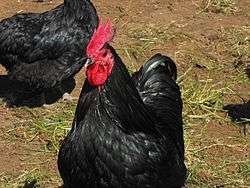Australorp
 Australorp rooster | |
| Conservation status |
|
|---|---|
| Other names |
|
| Nicknames | Australs |
| Country of origin | Australia |
| Standard | Australorp Club of Australia |
| Use | Dual-purpose breed: eggs, meat |
| Traits | |
| Weight |
Male: Large: 3.20–4.10 kg Bantam: 0.96–1.23 kg |
|
Female: Large: 2.250–3.10 kg Bantam: 0.79–1.04 kg[1] | |
| Skin color | White |
| Egg color | Brown |
| Comb type | Single |
| Classification | |
| APA | English |
| ABA | Single Comb and Clean Legged |
| PCGB | Soft Feather: Heavy[2] |
| APS | Heavy breed softfeather |
The Australorp is a chicken breed of Australian origin, developed as utility breed with a focus on egg laying. It achieved world wide popularity in the 1920s after the breed broke numerous world records for number of eggs laid and has been a popular breed in the western world since.[3] It is considered the honorary National Chicken Breed of Australia,[4] and The most popular colour of the breed is black, which is the only colour recognised in the United States of America,[3] but blue and white are also recognised in its home country[5] and the Poultry Club South Africa recognises buff, splash, wheaten laced and golden in addition.[6]
History

The original stock used in the development of the Australorp was imported to Australia from England out of the Black Orpington yards of William Cook and Joseph Partington in the period from 1890 to the early 1900s with Rhode Island Red. Local breeders used this stock together with judicious out-crossings of Minorca, White Leghorn and Langshan blood to improve the utility features of the imported Orpingtons. There is even a report of some Plymouth Rock blood also being used. The emphasis of the early breeders was on utility features. At this time, the resulting birds were known as Australian Black Orpingtons (Austral-orp).
The origin of the name "Australorp" seems to be shrouded in as much controversy as the attempts to obtain agreement between the States over a suitable national Standard. The earliest claim to the name was made by one of poultry fancy's institutions, Wiliam Wallace Scott, before the First World War. From 1925 Wal Scott set to work to have Australorp recognized as a breed with the Poultry Society as he developed the breed. Equally as persuasive a claim came in 1919 from Arthur Harwood who suggested that the "Australian Laying Orpingtons" be named "Australs". The letters "orp" were suggested as a suffix to denote the major breed in the fowl's development. A further overseas claim to the name came from Britain's W. Powell-Owen who drafted the British Standard for the breed in 1921 following the importation of the "Australian Utility Black Orpingtons." It is certain that the name "Australorp" was being used in the early 1920s when the breed was launched internationally. In 1929, the Australorp was admitted to the Standard of Perfection.
Colours and varieties

The Australorp, like many breeds of chicken, comes in both bantam and standard size and multiple colours.
The Australorp currently has three recognised colours according to the Australian Poultry Standard; black, white and blue. White Australorps have been recorded since 1949[7] but they were only recognised in the 2nd Edition of the Australian Poultry Standards in 2011.[8] South Africa recognises further colours; buff, splash, wheaten laced and golden.[6]
Eggs
It was the egg laying performance of Australorps that attracted world attention when in 1922-23 a team of six hens set a world record by laying 1,857 eggs for an average of 309.5 eggs per hen during a 365 consecutive day trial. It must be remembered that these figures were achieved without the lighting regimes of the modern intensive shed. Such performances had importation orders flooding in from England, United States of America, South Africa, Canada and Mexico. Well looked after Australorps lay approximately 250 light-brown eggs per year. A new record was set when a hen laid 364 eggs in 365 days.[9] They are also known to be good nest sitters and mothers, making them one of the most exceptional large, heritage utility breeds of chicken.
References
- ↑ The Standards. Australorp Club of Australia. Accessed August 2014.
- ↑ Breed Classification. Poultry Club of Great Britain. Accessed August 2014.
- 1 2 "AUSTRALORP CHICKEN". livestockconservancy.com. The Livestock Conservancy. Retrieved 15 November 2014.
- ↑ "Australian poultry breeds feature on stamps". auspost.com.au. Australia Post. Archived from the original on 29 November 2014. Retrieved 15 November 2014.
- ↑ Limited, Victorian Poultry Fanciers Association (2011). Australian poultry standards (2nd ed.). Ballarat, Vic.: Victorian Poultry Fanciers Association Limited (trading as Poultry Stud Breeders and Exhibitors Victoria). pp. 38–40. ISBN 9781921488238. Retrieved 15 November 2014.
- 1 2 "Soft Feather Breeds - Poultry Club South Africa". poultryclubsa.co.za. Poultry Club South Africa. Retrieved 15 November 2014.
- ↑ "White Australorps Breed True". Morning Bulletin. July 15, 1949. Retrieved 15 November 2014.
- ↑ "AUSTRALIAN POULTRY STANDARDS". australorps.com. Australorp Club of Australia. Retrieved 15 November 2014.
- ↑ "Australorp Chicken". Retrieved 18 July 2012.
- Backyard Poultry - Naturally, Alanna Moore, Bolwarrah Press, Bolwarrah, Vic, Australia, 1998. ISBN 0-9585590-1-5
- The American Standard of Perfection 1998 Edition, American Poultry Association, INC., Mendon, MA.
- The Australian Poultry Standard 1998 Edition .
- http://www.australorps.com/4.html - The Australorp Club of Australia: The Australian Poultry Standard for the Australorp.
External links
- Australorp Club of Australia Inc — contains pictures and information on the Australian Standards.
| Wikimedia Commons has media related to Australorp. |
- Australorp on PoultryHub
- Australorp — Chicken Breeds.